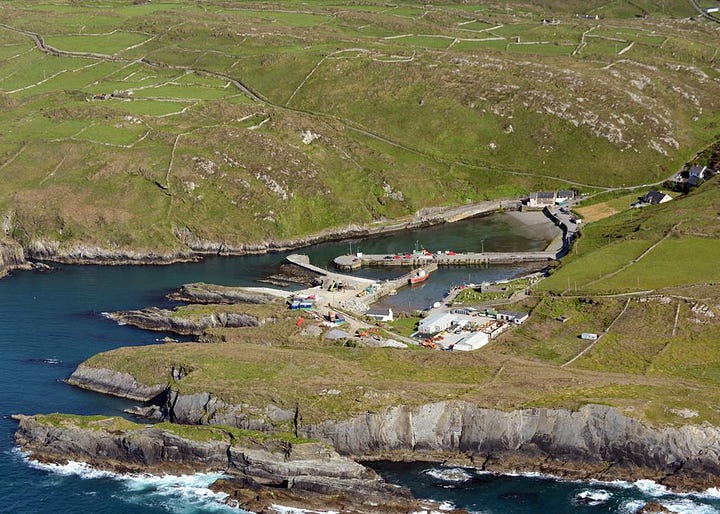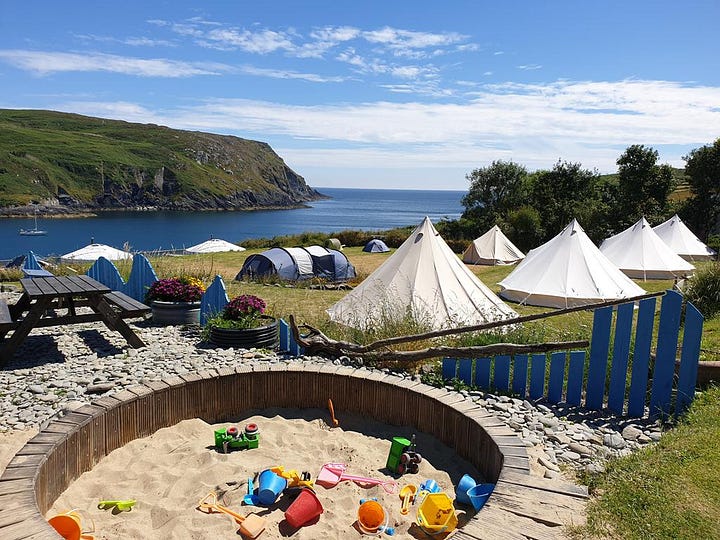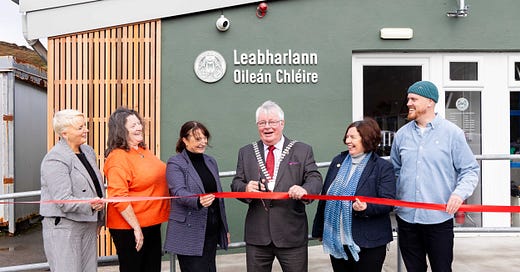Newly reopened Leabharlann Oileán Chléire sparks hope
Much like the island of Ireland, Oileán Chléire/Cape Clear needs a housing policy that works. T+D's Pádraig O’Connor gets a tour of the Atlantic island that's fighting on despite the tough odds.

As I was scribbling down a few notes outside the newly reopened library on Cape Clear on Tuesday morning, a local man dressed in a pair of navy overalls approached me from the side, without me even noticing. “Red tape," he said. “That’s appropriate. Because there was a lot of red tape to go through to finally get this on our island.”
I looked up at the ceremonies being conducted outside the new facility and could see the Mayor of County Cork Cllr Joe Carroll was getting ready to cut the ribbon to officially reopen the building.
“But it’s fantastic for the island,” the man continued. “It might be small, but for a place like this, it means a lot more than you could imagine.”
I put my notebook away. “Ye got a great day for it,” I said.
“We might get a burst of rain yet” he replied, while looking up at the sky.
“And how was the summer?” I asked. “Was it busy down here?”
“It wasn’t bad now. We’d plenty of visitors, but sure there’s no place for them to stay. That’s the one big problem we have here. There’s no accommodation for anyone and it’s impossible to get planning. We’ve been trying to see about Gateway Housing, but it hasn’t got the go ahead.”
Gateway Housing is an initiative which aims to provide affordable houses to families who’d like to move to the island on a trial basis. The houses would be owned by the island but would, some people believe, help encourage new people to come and live here. The scheme would also help prevent property on the island being purchased solely for the purpose of holiday homes and then lying vacant for most of the year.
“Living here is a way of life. It can be difficult at times, but you’d want to be here when the waves are crashing against the shore and there’s a mist overhead. There are sounds of nature here that you don’t get in other places.”
“Tá draíocht ar oileán. There’s magic on an island,” the man said and he repeated it again in Irish for emphasis. “Come on, we’ll go inside for a few sandwiches.”


Inside the new building there are multiple sized rooms; there is a computer room, a separate area for people to work remotely, a meeting room where members of the local community can gather for different activities, a back kitchen, a toilet and a shower room. It’s a lovely, bright space with huge potential.
A large group had gathered in the main meeting room and were chatting over cups of tea and coffee. Everyone seemed in great form, even the man who kept asking whether the hot water for the tea and coffee needed to be refilled. “If it needs more water, can’t you do it yourself?" a woman told him.
I took a few sandwiches and went back outside to sit in the sun and got talking to the island’s very own librarian Joan Kearney, who originally hails from Castleisland in Co. Kerry. She’s been living on Cape Clear for thirteen years and was delighted with the new facility, especially since she remembers having to scoop buckets of water out of the old portacabin when it was flooded.
“Hop in the van there,” she said, “and John will give you a tour of the island before you go.”
I got into the white minivan parked just outside the library and automatically went to put on my seat belt. “No seat belts are allowed on the island,” John said. I looked at his face to see if he might’ve been joking. He wasn’t. He started the engine and began the tour with a story about a crash on an island off the coast of Donegal, where the only person who survived was the one who wasn’t wearing a seatbelt and since then apparently they’ve not been used on islands around Ireland.
“This will only be a quick run down I’m afraid, because we’ll have to be back in time for the ferry at one.”
Quick run down or not, between the incredible beauty of the island and the fascinating crash course in history, the next thirty minutes or so were a pure joy, as John drove and talked about everything we passed by; the school with three teachers and three students, all of whom are German and whose first language is of course German, but their second is Irish.
While numbers to the island swell in summer, the population of Oileán Chléire was 110 in the 2022 census. In the years before the famine, more than 1,000 people lived on the island which is reached by ferry from Baltimore and Schull.
He talked of the story of the marriage rock, the “Cillin” or burial place for unbaptized children, the newly arrived alpacas being given Irish names, the places where people with leprosy were sent, the rock where a boat load of bacon crashed and why there are no sheep on the island. He talked of pirates, of the French, the English, the Algerians and around every turn and in every field there seemed to be another story. And another story. And another story.
On our way back, at the top of the narrow road overlooking the north harbor, John pulled the handbrake of the minivan and came to an abrupt halt. He pointed at a house in the distance and said that the man living there recently told him that his grandfather had told him a story about a tsunami that had hit the island and then he proceeded to pull out some pictures of a skull he found down by the graveyard, which he had sent to the police station in Skibbereen to send to the state pathologist.
“I’m still waiting to hear back from them.” he said “and that’s a few years ago now.”
We arrived back to the harbor at one on the dot. As the ferry pulled out, we were barely gone two minutes from the shore when we had to turn around again because someone had been left behind. We pulled out to leave a second time. The sun was shining down on the island and as I watched it from the top deck of the ferry as we headed back for the mainland, I could see the lavender being grown in the fields. I saw the stone walls and houses all facing the sea. I saw the birds flying overhead and there wasn’t a single cloud in the sky. It all looked a little magical.
Pádraig O' Connor raced down from Cork city to catch the ferry to Oileán Chléire and the ribbon cutting of Leabharlann Oileán Chléire. He was the only journalist present. T+D operates on the generosity of subscribers. If you can, please help us to keep on keeping on and reporting on stories such as this one.
From the T+D archive:
Swift action needed
The 10 small holes stacked in a triangular pattern high up on the gable end of the wall of the new parochial hall at Scoil Abán Naofa, Ballyvourney, are so unobtrusive that to most people, they might as well not exist.




